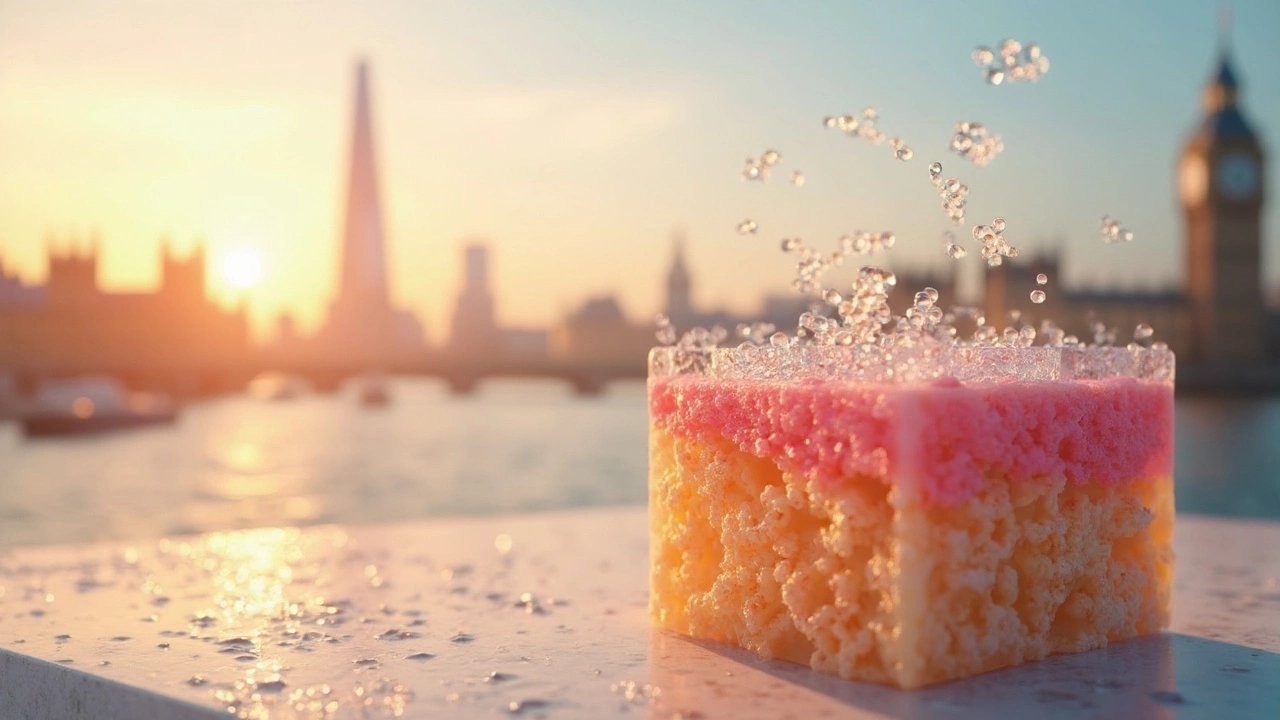Search for any skincare recommendation online, and CeraVe is pretty much unavoidable. There’s a reason for that—and, weirdly, it starts with the name. Spoiler: 'CeraVe' isn’t just a random jumble of letters or some fancy-sounding label. It’s all about ceramides and their vital role in your skin's health.
Ceramides are like the glue that keeps your skin barrier intact. If your skin gets dry, itchy, or sensitive, you can almost bet your ceramide levels are running low. That’s where CeraVe steps in: every product is loaded with these barrier-building ingredients, which explains why even dermatologists keep recommending it.
So, what does this mean for your daily routine? If you’re tired of dealing with flaky patches or want something gentle yet effective, CeraVe’s lineup is designed for exactly that. Most people—no matter if they're oily, dry, or acne-prone—can slot a CeraVe cleanser or moisturizer into their bathroom shelf and actually see results.
- The Real Meaning Behind CeraVe
- How Ceramides Work in Your Skin
- CeraVe’s Unique Approach: What Sets It Apart
- Should You Add CeraVe to Your Routine?
- Best Tips for Using CeraVe Products
The Real Meaning Behind CeraVe
If you’ve ever paused mid-scroll and wondered where the name CeraVe came from, you’re not alone. The brand wasn’t just trying to sound cool or high-end. There’s a real reason for the name, and it’s all about what’s inside the bottle.
CeraVe is a mashup of two key words: “ceramides” and “ve,” which stands for “vehicle.” So, CeraVe literally means “ceramide vehicle”—a brand that delivers ceramides into your skin. That’s not just marketing talk. The company actually partnered with dermatologists in the mid-2000s to come up with formulas that restore the skin barrier by replacing what your skin naturally loses, especially ceramides.
Here’s why ceramides matter: they keep your skin hydrated, plump, and protected. When they break down or get washed away (hello, harsh cleansers), your skin ends up losing water and becomes more sensitive. CeraVe packs three types of essential ceramides into every product to stop that from happening. Each ingredient is delivered steadily thanks to something called MultiVesicular Emulsion (MVE) technology, which lets your skin absorb the good stuff throughout the day—not just at the moment you slather it on.
- CeraVe means ceramide vehicle—it's all about delivering those skin-helper molecules where they’re needed most.
- MVE technology keeps ceramides working hour after hour, not just in the first couple minutes.
- Dermatologist-developed, so the formulas are based on legit skin science, not trends.
| Key Word | What It Stands For | Why It Matters |
|---|---|---|
| Cera (Ceramide) | Natural lipids in your skin | Protects and hydrates skin barrier |
| Ve (Vehicle) | Delivery system | Makes sure ceramides go deep and last longer |
So, next time you see the CeraVe logo in the skincare aisle, remember: it’s not just a brand, but a science-backed promise to keep your skin barrier strong and healthy, with deliverable, long-lasting hydration at its core.
How Ceramides Work in Your Skin
Think of ceramides as your skin’s tiny bodyguards. They're lipids, or fats, naturally found in the outermost layer of your skin. Their main job? Sealing in moisture and keeping junk like bacteria, pollution, and irritants out. Without enough ceramides, your skin starts losing water fast, leaving it dry, thin, and more likely to get irritated or inflamed.
Here’s an easy way to picture it: the top layer of your skin is like a brick wall. The skin cells are the bricks, while ceramides are part of the 'mortar' holding everything together. When ceramide levels drop, the wall gets cracks. That means water leaks out and irritants sneak in, causing problems like eczema, redness, and even breakouts.
A bunch of studies show a link between low ceramide levels and common skin issues. For example, researchers found people with eczema have 50% less ceramides in their skin than those without it. It's not just about dryness—less ceramides can mess with how your skin heals and deals with outside stress.
| Skin Condition | Ceramide Level | Impact |
|---|---|---|
| Normal Skin | Balanced | Healthy barrier, retains moisture |
| Dry Skin | Lowered | Flaky, rough, loses water |
| Eczema | Much lower | Itchy, inflamed, cracked |
Because your skin loses ceramides over time (thanks, aging and harsh soaps), rebuilding them matters. That’s actually the foundation of CeraVe’s formula. By topping up your skin’s ceramide stash, you strengthen its barrier. This means less water loss and an easier time dealing with everything from cold air to harsh cleansers.
- If your skin feels tight right after washing, you’re probably low on ceramides.
- Folks with sensitive or eczema-prone skin get a big boost from products with added ceramides.
- Using ceramide-packed moisturizers after a shower helps lock in more moisture than if you wait.
This isn’t some trendy ingredient—your skin actually can’t work well without a steady supply of ceramides. So, next time you’re picking out skincare, look for ceramides high up in the ingredient list if you want smoother, more comfortable skin.

CeraVe’s Unique Approach: What Sets It Apart
CeraVe didn’t just slap ceramides into a bottle and call it a day. What makes CeraVe really different is that they worked closely with dermatologists right from the start. Every formula packs in a mix of three essential ceramides (1, 3, and 6-II). These are the exact types your skin already has and needs to function its best.
But here's the kicker: CeraVe products use something called MVE® Delivery Technology. Instead of dumping everything on your skin all at once, this tech slowly releases hydration and ceramides over 24 hours. So, your skin keeps getting what it needs all day or night—even if you forget to reapply.
- Fragrance-free: CeraVe skips perfumes, making it less likely to freak out sensitive skin.
- Non-comedogenic: That means it won’t clog your pores, a win if you get pimples from heavy creams.
- Affordable: Unlike most dermatologist-approved brands, you won’t need to skip your latte to pay for your moisturizer.
- Gentle yet effective: You’ll find CeraVe recommended for acne, eczema, and even after harsh treatments like retinoids or acids.
There’s another thing: CeraVe sticks to the basics and doesn’t pile on trendy ingredients just because everyone else does. This ‘less is more’ style means fewer chances for irritation and more focus on what your skin barrier actually needs. No wonder the CeraVe name shows up everywhere from skincare TikTok to real dermatology offices.
Should You Add CeraVe to Your Routine?
If you’ve ever wondered whether CeraVe belongs on your shelf, you’re not alone. The hype around this brand isn’t just online buzz—there’s real science (and plenty of user proof) behind it. CeraVe is famous for making simple, fragrance-free products that deliver straightforward results. Even dermatologists in the U.S. named it their most-recommended moisturizer brand back in a 2023 survey. Now, let’s look at whether it’s a good pick for you.
Here’s what really makes CeraVe tick: every formula contains three essential ceramides—1, 3, and 6-II—plus stuff like hyaluronic acid or niacinamide that are known for locking in moisture or calming the skin. You won’t find harsh alcohols, heavy perfumes, or wild botanicals that often cause sensitivity. That makes CeraVe a go-to if your skin is dry, sensitive, or just fussy in general. But it’s not only for trouble-prone skin; their light, non-comedogenic lotions and gels work for oily types too.
- Gentle enough for eczema and rosacea (the National Eczema Association even gives its stamp of approval to several CeraVe products).
- Non-comedogenic, so won’t clog pores if you have acne-prone skin.
- Most formulas are safe to use morning and night, plus they layer well under sunscreens and makeup.
- Budget-friendly—unlike many popular brands, a big bottle of CeraVe usually costs less than two coffee shop lattes.
How does it stack up in real life? Check out these numbers:
| Product | Key Benefit | Avg. Rating on Amazon (June 2025) |
|---|---|---|
| Hydrating Cleanser | Gentle on dry/sensitive skin | 4.7/5 (40,000+ reviews) |
| Moisturizing Cream | Relieves and repairs dry skin | 4.8/5 (70,000+ reviews) |
| Foaming Facial Cleanser | Balances oily/combo skin | 4.6/5 (22,000+ reviews) |
If your goal is to make your CeraVe routine work, try starting with a basic non-foaming cleanser and a moisturizer. If breakouts or clogged pores are a concern, the Foaming Facial Cleanser is seriously popular with teens and adults alike. People also rave about adding the PM Facial Moisturizing Lotion before bed for all-night moisture without heaviness.
Don’t expect wild results overnight—consistent use matters. Most users start noticing smoother, calmer skin in about two weeks, sometimes less if their skin was already irritated. A small tip: always apply products to damp skin to lock in the hydration.

Best Tips for Using CeraVe Products
If you’re curious how to get the most out of your CeraVe products, a few simple tweaks can make your daily routine way more effective. This isn’t about adding dozens of steps or spending hours in the bathroom—just smart moves that fit real life.
Start by keeping these basics in mind:
- CeraVe shines as a gentle, fragrance-free option, so it’s perfect for sensitive or allergy-prone skin.
- Always apply to damp skin, not bone-dry—that little trick helps seal in more moisture.
- Layer lighter products first (think hydrating serums) before sealing it in with heavier CeraVe creams or ointments.
- Cleansers don’t need to create loads of foam to be effective. CeraVe’s formulas clean without stripping away natural oils.
- If you’re using actives (like retinol or vitamin C from other brands), make CeraVe your buffer—sandwich those stronger treatments between a CeraVe cleanser and moisturizer to minimize irritation.
Curious which CeraVe picks work best for different skin needs? Here’s a handy quick guide:
| Product | Best for | Key Ingredients |
|---|---|---|
| Hydrating Cleanser | Normal/Dry skin | Ceramides, Hyaluronic Acid |
| Foaming Cleanser | Oily/Combo skin | Ceramides, Niacinamide |
| Moisturizing Cream | Dry, sensitive, eczema-prone | Ceramides, Petrolatum |
| SA Cleanser | Rough/clogged skin | Ceramides, Salicylic Acid |
| AM Facial Moisturizing Lotion SPF 30 | Daily morning use/all skin types | Ceramides, Hyaluronic Acid, Sunscreen |
Don’t stress about mixing and matching—CeraVe is designed to play nice with most other brands as long as you listen to your skin. If you ever feel tightness or stinging, pause and see if spacing the layers out or choosing a richer formula helps. And don’t forget, all skin reacts differently, but starting slow and keeping it simple usually wins the day.


